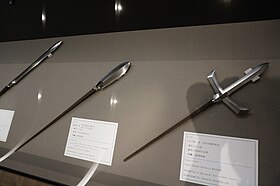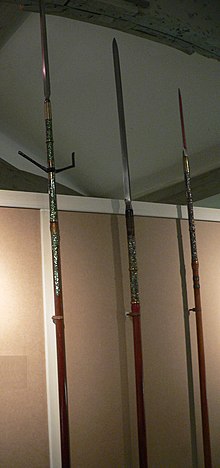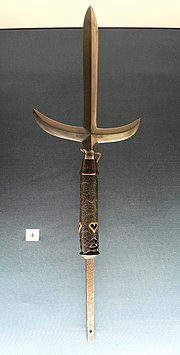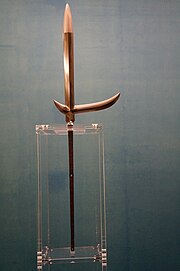Yari
| Yari(Thương) | |
|---|---|
 Yariforged by Echizen Kanenori, 17th century,Edo period(left),sasaho yariforged by Tachibana no Terumasa, 1686, Edo period (middle), andjūmonji yariforged by Kanabo Hyoeno jo Masasada, 16th century,Muromachi period(right) | |
| Type | Spear |
| Place of origin | Japan |
| Production history | |
| Produced | Nara period (710–794) forHoko yari, Muromachi period (1333–1568) for Yari, since 1334[1] |
| Specifications | |
| Mass | 1.27 kg (2.8 lb) |
| Length | 1–6 m (3 ft 3 in – 19 ft 8 in) |
| Blade length | 15–60 cm (5.9–23.6 in) |
| Bladetype | multiple blade shapes |
| Hilttype | Wood, horn, lacquer |
| Scabbard/sheath | Lacquered wood |

Yari(Thương)is the term for a traditionally-made Japanese blade ( Nhật Bản đao;nihontō)[2][3]in the form of aspear,or more specifically, the straight-headed spear.[4]Themartial artof wielding theyariis calledsōjutsu.
History[edit]

The forerunner of theyariis thought to be ahoko yariderived from aChinese spear.Thesehoko yariare thought to be from theNara period(710–794).[5][6]
The term'yari'appeared for the first time in written sources in 1334, but this type of spear did not become popular until the late 15th century.[1]The original warfare of thebushiwas not a thing for commoners; it was a ritualized combat usually between two warriors who would challenge each other via horseback archery.[7]In the late Heian period, battles on foot began to increase andnaginata,a bladed polearm, became a main weapon along with ayumi(longbow).[8]
The attemptedMongol invasions of Japanin 1274 and 1281 was one of the factors that changed Japanese weaponry and warfare. The Mongols employed Chinese and Korean footmen wielding long pikes and fought in tight formations. They moved in large units to stave off cavalry.[7]Polearms (includingnaginataandyari) were of much greater military use than swords, due to their significantly longer reach, lighter weight per unit length (though overall a polearm would be fairly hefty), and their great piercing ability.[7]
In theNanbokuchō period,battles on foot by groups became the mainstream and the importance ofnaginatafurther increased, butyariwere not yet the main weapon. However, after theOnin Warin 15th century in theMuromachi period,large-scale group battles started in which mobilizedashigaru(foot peasant troops) fought on foot and in close quarters, andyari,yumi(longbow) andtanegashima(Japanese matchlock) became the main weapons. This madenaginataandtachiobsolete on the battlefield, and they were often replaced withnagamakiand short, lightweightkatana.[8][9][10][11]
Around the latter half of the 16th century,ashigaruholding pikes (nagae yari) with length of 4.5 to 6.5 m (15 to 21 ft) became the main forces in armies. They formed lines, combined with soldiers bearing firearmstanegashimaand short spears. Pikemen formed a two- or three-row line, and were trained to move their pikes in unison under command. Not onlyashigarubut alsosamuraifought on the battlefield withyarias one of their main weapons. For example,Honda Tadakatsuwas famous as a master of one ofThe Three Great Spears of Japan,theTonbokiri( tinh linh thiết ). One of The Three Great Spears of Japan, theNihongō(ja: Nhật Bản hào) was treasured as a gift, and its ownership changed toEmperor Ogimachi,ShogunAshikaga Yoshiaki,Oda Nobunaga,Toyotomi Hideyoshi,Fukushima Masanori,and so on, and has been handed down to the present day.[12][13]
With the coming of theEdo periodtheyarihad fallen into disuse. Greater emphasis was placed on small-scale, close quarters combat, so the convenience of swords led to their dominance, and polearms and archery lost their practical value. During the peaceful Edo period,yariwere still produced (sometimes even by renowned swordsmiths), although they existed mostly as either a ceremonial weapon or as a police weapon.[12]
Description[edit]

Yariwere characterized by a straightbladethat could be anywhere from several centimeters to 3 feet (0.91 m) or more in length.[4]The blades were made of the same steel (tamahagane) from which traditionalJapanese swordsand arrowheads were forged, and were very durable.[4]Throughout history many variations of the straightyariblade were produced, often with protrusions on a central blade.Yariblades often had an extremely longtang(nakago;Trung tâm ); typically it would be longer than the sharpened portion of the blade. The tang protruded into a reinforced hollow portion of the handle (tachiuchiortachiuke) resulting in a very stiff shaft making it nearly impossible for the blade to fall or break off.[4]
The shaft (nagayeorebu) came in many different lengths, widths, and shapes; made of hardwood and covered in lacqueredbamboostrips, these came in oval, round, or polygonal cross section. These in turn were often wrapped in metal rings or wire (dogane), and affixed with a metal pommel (ishizuki;Thạch đột ) on the butt end.Yarishafts were often decorated with inlays of metal or semiprecious materials such as brass pins, lacquer, or flakes of pearl. A sheath (saya;Vỏ ) was also part of a completeyari.[4]
Variations ofyariblades[edit]
This sectionneeds additional citations forverification.(December 2022) |

Various types ofyaripoints or blades existed. The most common blade was a straight, flat design that resembles a straight-bladed double edgeddagger.[4]This type of blade could cut as well as stab and was sharpened like a razor edge. Though'yari'is a catchall term for 'spear', it is usually distinguished between'kama yari',which have additional horizontal blades, and simple'su yari'(choku-sō) or straight spears.Yarican also be distinguished by the types of blade cross section: the triangular sections were called'sankaku yari'and the diamond sections were called'ryō-shinogi yari'.[4]
- Sankaku yari(Tam giác thương,"triangle spear" )have a point that resembles a narrow spike with a triangular cross-section. Asankaku yaritherefore had no cutting edge, only a sharp point at the end. Thesankaku yariwas therefore best suited for penetrating armor, even armor made of metal, which a standard yari was not as suited to.[4]There are two types ofsankaku yari:sei sankaku yari,yariblades with a triangular, equilateral cross section, andhira sankaku yari,yariwith a triangular, isosceles-shaped cross section.
- Ryō-shinogi yari,a blade with a diamond shaped cross section.
- Fukuro yari(Túi thương,"bag" or "socket spear" )were mounted to a shaft by means of a metal socket instead of a tang. The socket and blade are forged from a single piece.
- Kikuchi yari(Cúc trì thương,"spear of Kikuchi" )were one of the rarest types ofyari,possessing only a single edge. This created a weapon that could be used for hacking and closely resembled atantō.Kikuchi yariare the onlyyariwhich use ahabaki.
- Yajiri nari yari(Thốc hình thương,"spade-shaped spear" )had a very broad, "spade-shaped" head.Yajiri nari yarioften had a pair of holes centering the two ovoid halves.

- Jūmonji yari(Mười văn tự thương,"cross-shaped spear" ),also calledmagari yari(Khúc thương,"curved spear" ),looked something similar to atridentorpartisan,and brandishing two curved side blades pointing upward. It is occasionally referred to as'maga yari'in modern weaponry texts.
- Jogekama yari,ajūmonji yariwith one side blade pointing downward and one side blade pointing upward.
- Karigata yari,ajūmonji yariwith the two side blades pointing downward.
- Gyaku yari,ajūmonji yariwith the two side blades resembling a pair of buffalo horns.
- Kama-yari(Liêm thương,"sickle spear" )gets its name from a peasant weapon or tool calledkama(lit. "sickle" or "scythe" ).

- Kata kamayari(Phiến liêm thương,"single-sided sickle spear" )had a weapon design sporting a blade that was two-pronged. Instead of being constructed like amilitary fork,a straight blade (as insu yari) was intersected just below its midsection by a perpendicular blade. This blade was slightly shorter than the primary, had curved tips making a parallelogram, and was set off center so that only 1/6 of its length extended on the other side. This formed a rough 'L' shape.
- Tsuki nari yari(Nguyệt hình thương,"moon-shaped spear" )barely looked like a spear at all. A polearm that had a crescent blade for a spearhead, which could be used for slashing and hooking.
- Kagi yari(Câu thương,"hook spear" )was a key-shaped spear with a long blade with a side hook much like that found on afauchard.This could be used to catch another weapon, or even dismount a rider mounted on horseback.
- Bishamon yari(Bì sa môn thương)possessed some of the most ornate designs for any spear. Running parallel to the long central blade were two 'crescent moon' shaped blades facing outwards. They were attached in two locations by short cross bars, making the head look somewhat like afleur-de-lis.
- Hoko yari,an old form ofyaripossibly from the Nara period (710–794),[14]a guard's spear with 6 ft (1.8 m) pole and 8 in (200 mm) blade either leaf-shaped or waved (likekeris); a sickle-shaped horn projected on one or both sides at the joint of blade.[15]Thehoko yarihad a hollow socket like the later periodfukuro yarifor the pole to fit into rather than a long tang.[16]
- Sasaho yari(Thế tuệ thương),a broadyaridescribed as being "leaf shaped" or "bamboo leaf shaped".[17]
- Su yari(Tố thương,"simple spear" )(alao known assugu yari), a straight double edged blade.[18]
- Omi no yari(omi yari), an extra longsu yariblade.[18]
- Makura-yari(Gối thương,"pillow spear" )
- Choku-yari(Thẳng thương,straight spear ")[19]
Variations ofyarishafts[edit]
Ayarishaft can range in length from 1–6 metres (3 ft 3 in – 19 ft 8 in), with some in excess of 6 metres.
- Nagae yari( "long shafted spear" ):16.4 to 19.7 ft (5.0 to 6.0 m) long, a type of pike used byashigaru.[20][21]It was especially used byOda clanashigarubeginning from the reign ofOda Nobunaga;samurai tradition of the time held that the soldiers of the rural province ofOwariwere among the weakest in Japan.Kantōwas a chaotic place;Kansaiwas home to theShogunate,and theUesugi,Takeda,Imagawa,andHojoclans, as well as pirate raiders fromShikoku.Additionally, Kyushu was home of one of the most warmongering clans in Japan, theShimazu clan.Because of this, Nobunaga armed his underperformingashigarusoldiers extra-long pikes in order for them to be more effective against armoured opponents and cavalry, and fighting in groups and formations.
- Mochi yari(Cầm ち thương,"hand spear" ),a long spear used byashigaruand samurai.[22]
- Kuda yari(Quản thương,"tube spear" ).The shaft goes through a hollow metal tube that allowed the spear to be twisted during thrusting. This style ofsojutsuis typified in the schoolOwari Kan Ryū.
- Makura yari(Gối thương,"pillow spear" ).Ayariwith a short simple shaft that was kept by the bedside for home protection.[23]
- Te yari(Súng lục,"hand spear" ).Ayariwith a short shaft that was used by samurai and police to help capture criminals.[24]
Gallery[edit]
-
Kikuchi yari
-
Sasaho yari
-
Sankaku yari
-
Ryo shinogi fukuro yari
-
Tachiuchiortachiuke,the reinforced upper part of the shaft
See also[edit]
References[edit]
- ^abFriday, Karl(2004).Samurai, Warfare and The State in Early Medieval Japan.Routledge. p. 87.ISBN0-415-32962-0.
- ^The Development of Controversies: From the Early Modern Period to Online Discussion Forums,Volume 91 of Linguistic Insights. Studies in Language and Communication, Author Manouchehr Moshtagh Khorasani, Publisher Peter Lang, 2008,ISBN3-03911-711-4,ISBN978-3-03911-711-6P.150
- ^The Complete Idiot's Guide to World Mythology,Complete Idiot's Guides, Authors Evans Lansing Smith, Nathan Robert Brown, Publisher Penguin, 2008,ISBN1-59257-764-4,ISBN978-1-59257-764-4P.144
- ^abcdefghRatti, Oscar; Adele Westbrook (1991).Secrets of the Samurai: The Martial Arts of Feudal Japan.Tuttle Publishing. p. 484.ISBN978-0-8048-1684-7.
- ^Japan and China: Japan, its history, arts, and literature,Frank Brinkley, T. C. & E. C. Jack, 1903 p.156
- ^The connoisseur's book of Japanese swords,Kōkan Nagayama, Kodansha International, p.49
- ^abcDeal, William E (2007).Handbook to Life in Medieval and Early Modern Japan.Oxford University Press. p. 432.ISBN978-0-19-533126-4.
- ^abBasic knowledge of naginata and nagamaki.Nagoya Japanese Sword Museum, Touken World
- ^Arms for battle – spears, swords, bows.Nagoya Japanese Sword Museum, Touken World
- ^Kazuhiko Inada (2020),Encyclopedia of the Japanese Swords.p42.ISBN978-4651200408
- ^Lịch sử ngườiSeptember 2020. pp.40–41.ASINB08DGRWN98
- ^abLịch sử ngườiSeptember 2020. pp.128–135.ASINB08DGRWN98
- ^Three Great Spears of Japan.Nagoya Japanese Sword Museum, Touken World.
- ^The new generation of Japanese swordsmiths,Tamio Tsuchiko, Kenji Mishina, Kodansha International, 2002 p.15
- ^The Encyclopedia Americana: a library of universal knowledge,Volume 15 Encyclopedia Americana Corp., 1919 p.745
- ^The Japanese swordKanzan Satō, Kodansha International, 1983 P.63
- ^The connoisseur's book of Japanese swords,Kōkan Nagayama, Kodansha International, 1998 p.49
- ^abThe connoisseur's book of Japanese swords,Kōkan Nagayama, Kodansha International, 1998, P.49
- ^Armstrong, Hunter B."The Sliding Yari of the Owari Kan Ryu".koryu.Retrieved29 October2020.
- ^Fighting techniques of the Oriental world, AD 1200–1860: equipment, combat skills, and tactics,Authors Michael E. Haskew, Christer Joregensen, Eric Niderost, Chris McNab, Publisher Macmillan, 2008,ISBN0-312-38696-6,ISBN978-0-312-38696-2P.44
- ^Ashigaru 1467–1649,Stephen Turnbull, Howard Gerrard, Osprey Publishing, 2001, P.19
- ^Ashigaru 1467–1649,Authors Stephen Turnbull, Howard Gerrard, Illustrated by Howard Gerrard, Publisher Osprey Publishing, 2001,ISBN1-84176-149-4,ISBN978-1-84176-149-7P.23
- ^Samurai: The Weapons and Spirit of the Japanese Warrior,Author Clive Sinclaire, Publisher Globe Pequot, 2004,ISBN1-59228-720-4,ISBN978-1-59228-720-8P.119
- ^Taiho-jutsu: law and order in the age of the samurai,Author, Don Cunningham, Publisher Tuttle Publishing, 2004,ISBN0-8048-3536-5,ISBN978-0-8048-3536-7P.44

